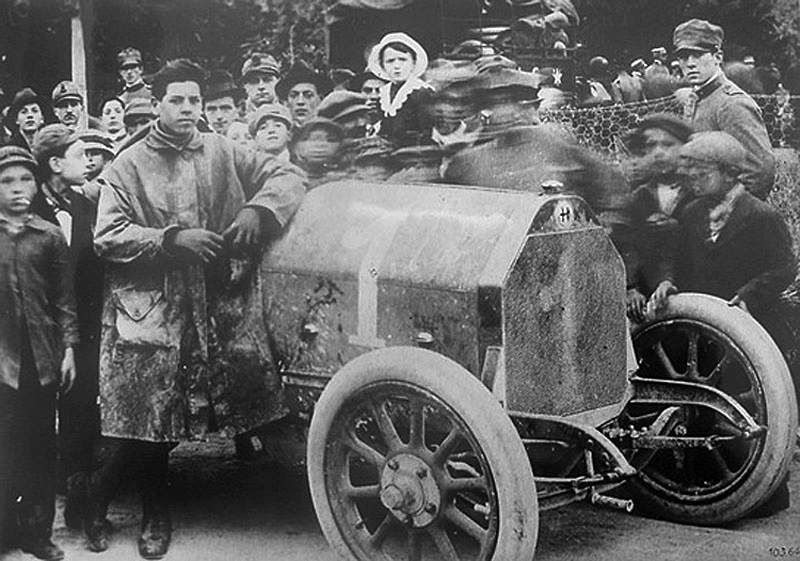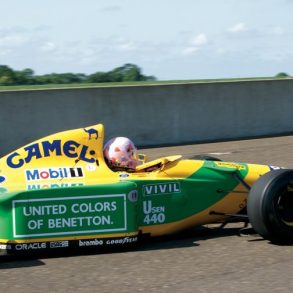Giulio Ramponi Biography
Giulio Ramponi was born in Milan on 8 January 1902. His father died while he was still a small boy and his mother re-married. Giulio showed an aptitude in mechanical matters and took a technical course at the Arti e Mestieri school in via Santa Maria. While working for Pelizzola, a fuel pump company he attracted the attention of Giuseppe Campari, A friend of his stepfather’s, who was looking for a riding mechanic for the imminent Parma-Poggio di Berceto hill climb. Ramponi joined Alfa Romeo as an apprentice while acting as riding mechanic to Campari. At Alfa Romeo, he duly passed through the engine test section, then spent six months on running gear assembly. Ramponi then joined the experimental department run by Luigi Bazzi. At the same time, Ramponi received driving lessons from Attilio Marinoni, the company’s chief test driver.
He was driving a big, pre-war Alfa, but when the bonnet flew off, I had to retrieve it and lie along the cowl holding it down! Exhausted but ecstatic when they crossed the line, for the burly Campari was not known for his smooth driving style, I jumped to the ground before the car stopped and fell flat on my face, in front of the crowds! But the great driver Felice Nazzaro was so good, he helped me up and congratulated me! – Ramponi
In 1923 the legendary, but demanding designer Vittorio Jano arrived on the scene, having been lured from Fiat to design a new racing car for Alfa Romeo. The young Ramponi became involved in the ambitious competition program that resulted in the world beating P2 Grand Prix car. While all that was going on Ramponi’s own competition experience had been mixed with several retirements followed by a string of good results alongside drivers such as Campari, Antonio Ascari, and Enzo Ferrari.
By 1924 the new P2 model was ready to enter the world stage and Giulio was chosen to take charge of Antonio Ascari’s car. As a warm-up the pair were entered in the Targa Florio, on the 27 April, in one of the older RL Targas. The pair were heading for victory, with a comfortable lead over Werner’s Mercedes, when the engine seized within sight of the finish. Ascari and Giulio immediately leapt out and struggled with the starting handle, but to no avail. They began to push the car to the line, assisted by several soldiers and spectators, but as the clock ticked away they slipped to second place behind Werner. Unfortunately a protest was made — on the grounds that only the crew were allowed to push their car and the Alfa Romeo was disqualified.
Their next outing together was the French Grand Prix at Lyon, the debut of the P2 at the highest level. Ascari had already won the Circuito di Cremona on the car’s public debut which occurred contrary to the wishers of it’s designer Jano , but on that occasion Luigi Bazzi had occupied the mechanic’s seat. In France, Giulio reclaimed his place alongside Ascari, but unfortunately for both of them the P2 failed, within sight of victory, on the thirty-second lap. Ascari managed to reach the pits where Ramponi changed the plugs and added water to the radiator. Both men then tried desperately to re-start the engine but their race was over and the pair had to stand by and watch as Campari claimed the first major victory for the P2.
A rule change for 1925 banned the use of riding mechanics during Grand Prix races. It was a change that probably saved Giulio’s life. He remained in charge of the preparation of Ascari’s car but was stationed safely in the pits when disaster struck in the French Grand Prix.
Ramponi scoffed at the commonly-held reason that Antonio’s crash was the fault of rain or a wet track. During practice Campari had, most unusually, set a faster time than Ascari. Grid positions being decided by ballot in those days, the team gave their fastest drivers the front positions. This always went to the younger and more talented Ascari, Alfa’s number one.
“But one of the directors, Rimini, who normally didn’t attend and knew nothing about racing, insisted that Campari be given the front slot, based on his practice time. Ascari was furious, for there had always been some envy and friction between the two drivers. Antonio had a point to prove and charged ahead from the start, increasing his lead despite my signals to slow down. He just misjudged that long corner. It was not even raining at the time, and he died in my arms.” The 24-year-old Giulio fainted, and took some time to recover, for he idolised Ascari, telling me “He was the first Nuvolari, very soft on his cars, smooth and so fast.”
Whilst continuing to work in the racing department, Ramponi was assigned to the important role of chief test driver for the new Alfa Romeo 6C 1500 project. Working directly under Jano he was allowed to enter the Cuneo—Maddalena hillclimb in August 1927. Having received instructions to take care and make sure that he finished, Ramponi came home in third place.
In 1928 Ramponi served as rinding mechanic to Campari in a supercharged version of the Alfa Romeo 6C 1500 Sport Spider Zagato. The Campari/Ramponi entry won the race beating a strong OM and Lancia opposition, leading the first OM home by around fourteen minutes. The following year the duo drove an upgraded Alfa Romeo 6C 1750 home in first place ahead of an OM by a mere 8 minutes — after a race that lasted 18 hours!
Ramponi’s own racing career finally started to bear fruit … in England. The 1928 Essex Motor Club Six Hour Race at Brooklands was the biggest win of Giulio’s career so far as a driver. The following year he returned but now Junior Car Club organized a 24 hour race at the track. The residents of Weybridge were none too keen on night racing at the track so the event was split into two twelve-hour parts, run between 8 am and 8 pm. Four of the latest Alfa 1500 Super Sport models were collected from Italy then driven to England by Giulio, Count ‘Johnny’ Lurani, Perfetti, a works mechanic, and the works foreman, W.E. Dunkley. Once again Ramponi won on handicap from the Davis/Gunter 4.5 litre Bentley at an average speed of 77.37 mph. Another Bentley placed third with Boris Ivanovsky’s Alfa in fourth. Ramponi won a generous prize fund but his proposal that his mechanic, Perfetti, should receive a percentage of the prize fund was rejected out of hand by the Alfa Romeo management less other mechanics get any ideas.

It had all started when Whitney Straight, a wealthy American went to Italy and bought a pair of Maseratis direct from the factory in Bologna. Whilst in Italy shopping for cars, Straight made contact with Ramponi and soon Giulio was headed back to England as chief engineer for the new team. Amongst the other mechanics was one Billy Rockell, a former Bentley mechanic, who would later would go into partnership with Ramponi. Although Straight and his team enjoyed some success the American abruptly decided to retire from racing at the end of 1934. As one last job for Straight, Ramponi and Rockell converted one of the Maseratis into a road-legal sports car. This work was carried out at a shop in Lancaster Mews close to London’s Hyde Park; this address would become the home of the Ramponi Rockell business. During his time with Straight, Ramponi had also taken on the preparation of an MG for a talented young English driver named Richard Seaman.
After Straight’s retirement from racing, Seaman asked Ramponi to prepare an ERA for the 1935 season. Seaman enjoyed little success with the car and asked Ramponi to look out for something better for the following year. That decision would lead a ten year old Grand Prix Delage that would propel Seaman into the front rank of motor racing in 1937 with Mercedes Benz and the car, the Black Delage into immortality. When Seaman died at Spa, Belgium in 1939 Ramponi was heartbroken, for Seaman had been like a son to him and he had great hopes for his career.
World War II reached England and Ramponi even though an anti-fascist, was interned as an enemy alien to a camp on the Isle of Man. Released in 1944, Ramponi worked for a short time at Bristol-Siddeley, contributing towards the allied war effort, before re-emerging at the end of the war at Lancaster Mews where the old Ramponi Rockell team were soon back in action selling and servicing Alfa Romeos. Having visited South Africa with Whitney Straight before the war Ramponi retired to South Africa in 1973, he died in December 1986.



















